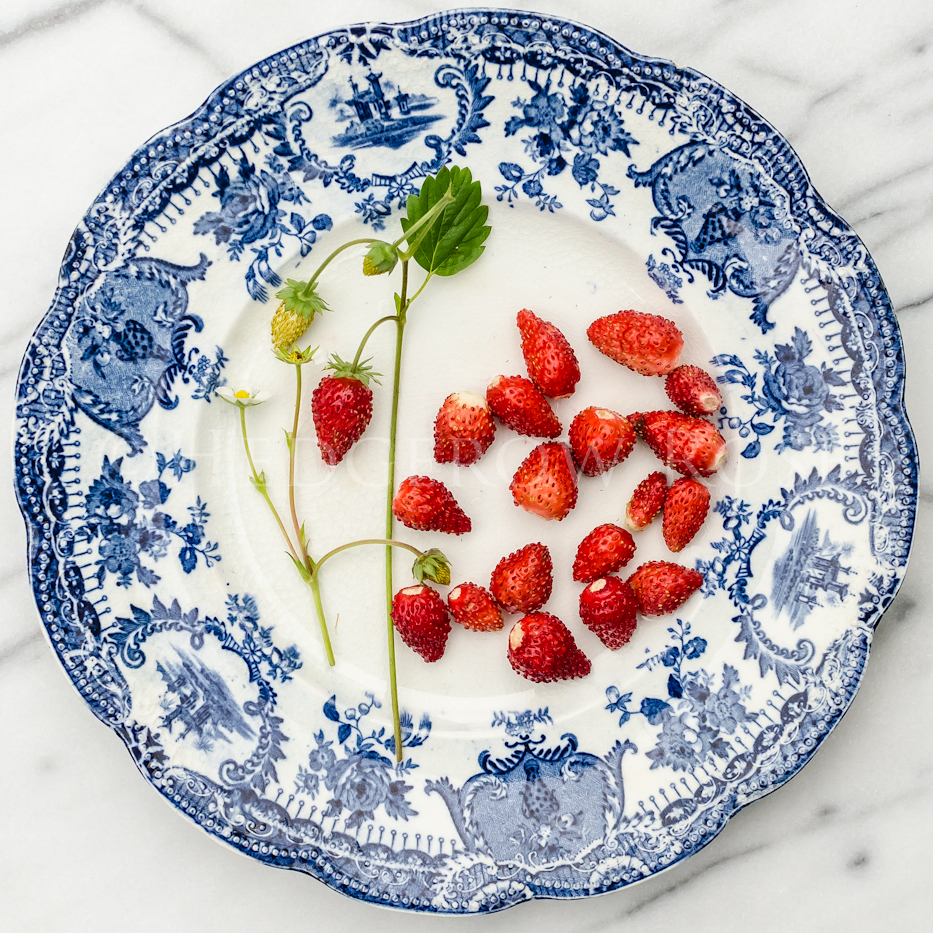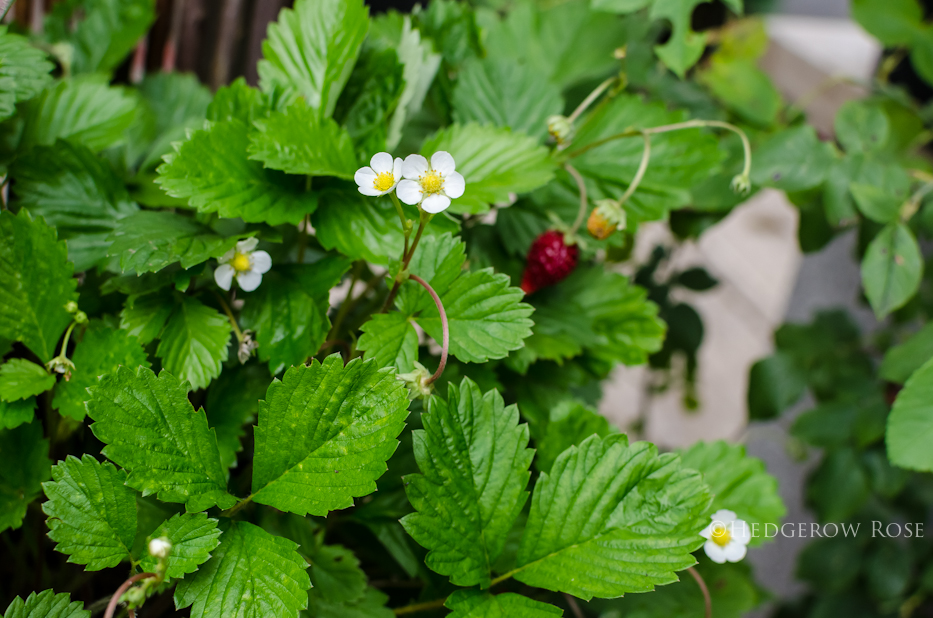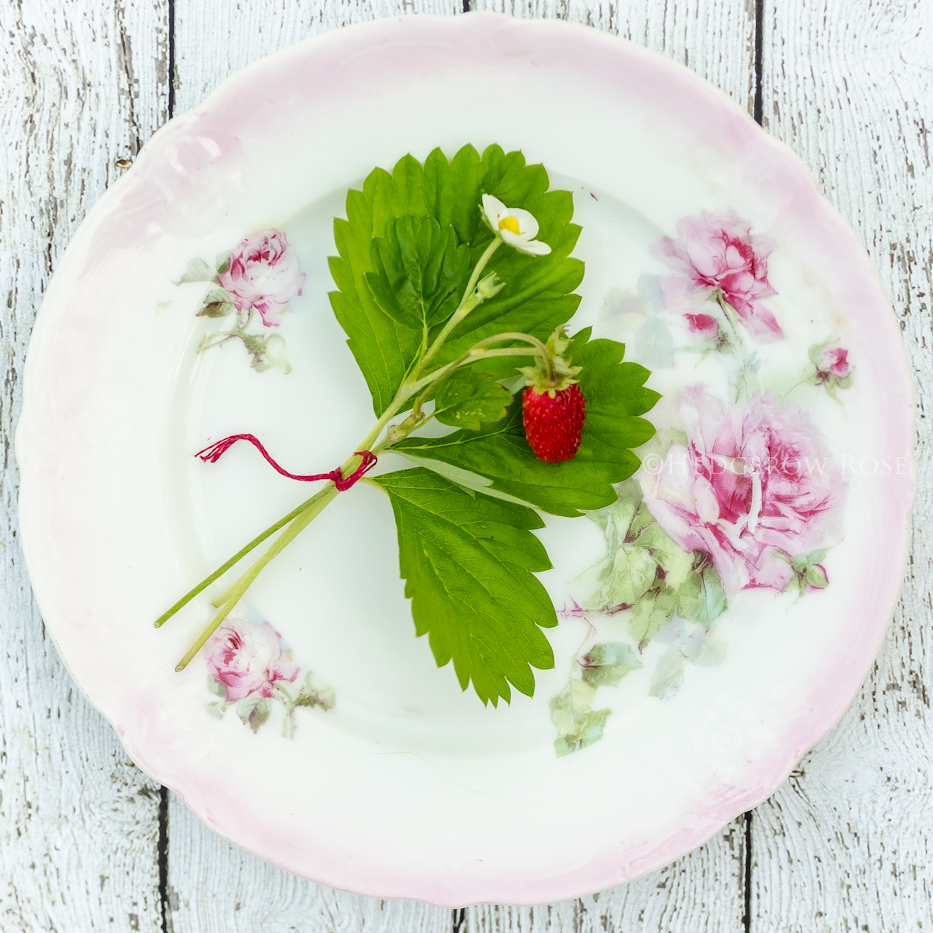Growing: Alpine Strawberries (Fragaria vesca) ‘Mignonette’
 Alpine Strawberries ‘Mignonette’
Alpine Strawberries ‘Mignonette’
Today I’m roasting winter squash (harvested about a month ago from our garden) for a spicy squash and black bean soup–fitting fare for a week that’s seen temperatures drop into the low 30’s at night. Outside my window the leaves on the hardwoods are lighting up like beacons of red and gold and yet there is also a patch of ‘Mignonette’ Alpine Strawberries still bearing fruit in the garden. In fact, I just picked a handful before I sat down to write this post.
 Yes, these strawberries have been producing since early summer and have barely taken a moment of pause. Until recently, I have always felt a bit strawberry challenged. No matter how large and healthy our strawberry plants, the amount of berries that actually made it to our table seemed like a poor ratio. Tired of plants with runners taking over the world and berries so irresistible to our gang of chipmunk thugs, I decided to grow Alpines instead, and these little plants have made me a believer in garden-grown strawberries again.
Yes, these strawberries have been producing since early summer and have barely taken a moment of pause. Until recently, I have always felt a bit strawberry challenged. No matter how large and healthy our strawberry plants, the amount of berries that actually made it to our table seemed like a poor ratio. Tired of plants with runners taking over the world and berries so irresistible to our gang of chipmunk thugs, I decided to grow Alpines instead, and these little plants have made me a believer in garden-grown strawberries again.

 Alpine strawberries, or Fraises des Boises as they’re sometimes called, are descended from the wild woodland type and have been cultivated for centuries. Their fruit are small and conical and have an delicious and unique flavor–a burst of strawberry followed by a rose-like perfume. They form a tidy, runner-free clump which can be divided in spring, and as I mentioned earlier, produce fruit all season long. In our garden, I have 6 plants growing in a larger wooden container filled with compost rich potting soil placed in full sun. During the summer I watered with liquid kelp and kept them tidy by trimming back the older, dying leaves. (If you’re looking for further information and growing tips, I think Renee of Renee’s Garden does a smashing job with this article HERE.) ‘Mignonette’ can be started from seed, of course, but I purchased small, live plants last spring since I wanted to get fruit right away.
Alpine strawberries, or Fraises des Boises as they’re sometimes called, are descended from the wild woodland type and have been cultivated for centuries. Their fruit are small and conical and have an delicious and unique flavor–a burst of strawberry followed by a rose-like perfume. They form a tidy, runner-free clump which can be divided in spring, and as I mentioned earlier, produce fruit all season long. In our garden, I have 6 plants growing in a larger wooden container filled with compost rich potting soil placed in full sun. During the summer I watered with liquid kelp and kept them tidy by trimming back the older, dying leaves. (If you’re looking for further information and growing tips, I think Renee of Renee’s Garden does a smashing job with this article HERE.) ‘Mignonette’ can be started from seed, of course, but I purchased small, live plants last spring since I wanted to get fruit right away.
 The six plants I cultivated supplied enough berries to give me several to a small handful of strawberries daily. Since they are so tiny and best eaten right away, I hardly ever shared, I’ll admit! But in my defense, I did announce that the strawberries were there for the picking…I just happened to get to them first because a gal’s gotta keep her strength up when she’s gardening, right? I’m hoping the sunshine holds out long enough to finish ripening the final berries on our plants and then I’m going to roll that container into the garage for the winter. Next spring, I’ll divide and try growing the extras in a traditional strawberry jar. Pretty awesome, huh?
The six plants I cultivated supplied enough berries to give me several to a small handful of strawberries daily. Since they are so tiny and best eaten right away, I hardly ever shared, I’ll admit! But in my defense, I did announce that the strawberries were there for the picking…I just happened to get to them first because a gal’s gotta keep her strength up when she’s gardening, right? I’m hoping the sunshine holds out long enough to finish ripening the final berries on our plants and then I’m going to roll that container into the garage for the winter. Next spring, I’ll divide and try growing the extras in a traditional strawberry jar. Pretty awesome, huh?
 Did you grow strawberries this summer? Which varieties were your favorite?
Did you grow strawberries this summer? Which varieties were your favorite?

For realsies I have been trying to grow strawberries for years with terrible results. I am excited to try this variety!
Thanks Christin! I was always the same way and was about to give up on them. Try these and let me know what you think. 🙂
Wow! Your berries turned out gorgeous! I’ve tried alpine strawberries for two years, but I guess the Kansas climate doesn’t agree with them.
Hi Joe! Maybe give these a whirl? I was about to give up on strawberries too until I tried the Alpines. 🙂
So lovely. Alpine strawberries are some of my favorites. I grew one plant that was considered an alpine (didn’t have its name on the label) this year and it continued producing all summer, too. I’m going to have to look for more for next year.
If I can get these divided up this spring (as you already know we’re in a possible move situation) I can share some with you!